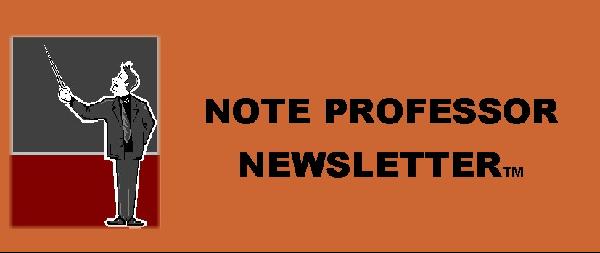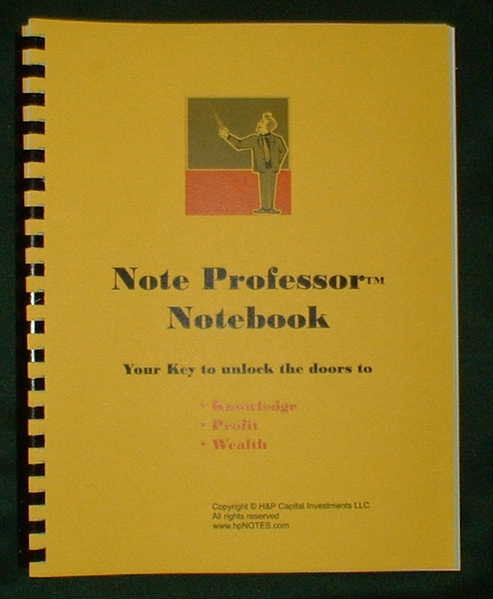|
|

|
|
||||||
|
||||||
| SEMINAR Dallas Tx |
February 10 & 11
GET RICH WITH NOTES SEMINAR with Tom Henderson. After completing this workshop, you will be heads and shoulders above the “wanna be investor”. Whether you are a wholesaler, rehabber, or you want to buy and hold, you will be able to put deals together, that others would have passed by. This means money in your pocket. Register early to receive your manual prior to class. CLASS SIZE LIMITED TO 20 STUDENTS. A 2 day event 02/10/2007 Saturday 9am-12 02/11/2007 Sunday 1-5pm. To forward this email to friends or business associates who have an interest in real estate, click the "forward button" at the very bottom of this newsletter. |
|||||
|
||||||
| by Tom Henderson |
In the last issue of THE NOTE PROFESSOR NEWSLETTER , I showed you how finance companies and mortgage companies will increase their earnings by giving you a “Christmas Gift” of not having to make your December payment. Now that Christmas is over, are you seeing all kinds of adds saying, “Zero Interest” Do you ever wonder how the merchant can do this and still make money? When you know the concepts of the time value of money, what is happening is simple. Let’s look. A furniture store advertises it will sell you a complete bedroom set for $3,000 with zero interest, for 36 months. Let’s get out our friendly neighborhood calculator and see what is happening. (Remember, I usually put the minus sign in front of PV because I assume I am going to buy the note. This should give you a hint as to what is going down.) Now for a “behind the scenes” look at what the merchant is doing. Retailers use terms like “keystone” or “three marks”. Keystone means they have doubled the price they paid for the product, and three marks means the retailer has tripled the price of the product. For example, if a product cost the merchant $100, it would sell for $200 if “keystoned” or $300 if “three marked”. With this in mind, we see that 25% off still gives the retailer a profit, while making the product more affordable. Retailers must, I say again, MUST move their inventory quickly, if they want to stay in business. If you think cash flow is important in the real estate business, try purchasing several hundred thousand dollars of a product and have it sitting on your show room floor. Yet with high priced items like the bedroom set, going down on the price 25% to $2,250, still might not move expensive inventory. What can the retailer do to make the product more affordable? What if, rather than going down on the price, the merchant could sell it on credit, with 0 down, and 0 interest? Think they would have any takers? Yep! How does this look? N= 36 I/Yr= 0 PV= $ -3,000 PMT= $83.33 FV= 0 Looks attractive to the consumer, does it not? For only $88.33 a month, the consumer can enjoy a brand new $3,000 bedroom set. But retailers cannot stay in business unless they move their products for cash, and quickly. What are they to do? You guessed it. SELL THE NOTE. Let’s say that instead of giving a 25% discount to the consumer, the retailer discounted the note 25%. What kind of yield would this give to the note buyer? N= 36 I/Yr= 19.75 PV= $ -$2,250 PMT= $83.33 FV= 0 So if the retailer “keystoned” the product, the retailer still enjoyed a $750 profit and moved the inventory quickly by offering it on credit, with 0 percent interest. Play with your calculator to see the different possibilities if the retailer “triple decked” the product. Armed with this knowledge, you might go to the retailer and offer to purchase the product for say $2,000 cash, or match the discount of the note buyer. Often times the merchant will agree just to move the product and get cash immediately. The merchant does not care where the money comes from. Now you know another “trick of the trade”. One word of caution, if you decide to purchase on such a plan, LOOK AT THE TERMS. Often the terms will state that if you are late on ANY payment, or if there are more than two reruns of “I Love Lucy” in any given week, the interest rate will go to 7% to $15% This is going to result in either your payments going up, the length of payments increasing, or both. So be careful. What happens when they offer zero percent interest, and no payments for 3 months? Would love to get into this, but we would have to delve into Net Present Values and IRRs, however we have run out of time, and my fingers are getting tired. Is it becoming clearer as to why investors and institutions buy notes? If you want to learn more about HOW TO GET RICH WITH NOTES, and learn how to structure notes in real estate deals to get maximum yields, plus “nothing down” techniques; click here to sign up for my February 10th & 11th 2007 class. This is a “hands on” class, not a “teaser seminar.” I limit the class size to 20, so register early to take advantage of the discount and assure a seat. If you have any questions or comments, be sure to contact me. In the subject line, write ASK the PROFESSOR. I will try to answer your questions in the next Note Professor issue. Remember, if you know of someone who has a note to sell, I do pay referral fees. To forward this email to friends or business associates who have an interest in real estate, click the "forward button" at the very bottom of this newsletter I have a new Get a Note Quote web page that can be filled out and submitted for an online note quote. Check it out. Tom Henderson /a.k.a. THE NOTE PROFESSOR . Copyright H&P Capital Investments LLC All rights reserved |
|||||
|
||||||
| By Tom Henderson |
I have been getting questions concerning the different terms offered by hard money lenders. Some HMLs will offer interest only with several points, while others offer lower interest amortized over 30 years with fewer points. Which one is the better offer? Looking at a HML offer is a good way to demonstrate how points affect the interest rate you are paying. Also at the same time, I will show you how to calculate which is the better deal, interest rate wise, on different offers made by HMLs. Remember, all we are doing is applying the 5 variables of the time value of money, and coming up with an answer. Let’s look at typical situation. You find a house that is worth $100,000 ARV, that you can pick up for $50,000 and it will take $15,000 to fix up. You want to borrow $65,000 from a friendly neighborhood hard money lender, so you shop around, and lo and behold, they are offering you what you think are apples and oranges. Different terms, points and interest rates. Here is a HML offer where we will learn not only how to calculate points, but also to see how points affect your loan. I am not going to delve into the legalities of the HMLs, but merely the number crunching. One hard money lender is offering to loan you $65,000 at 14% interest only, with monthly payments and 4 points. The loan is due within one year. What interest are you really paying? N =12 I/YR=14 PV =$65,000 PMT = $-758.33 FV $-65,000 Hang on, there. Remember, there are 4 points, or 4% the HML is charging up front. This means that he is not actually funding $65,000 but only $62,400. ($65,000-$2,600). Let’s plug these real figures into our calculator and see what happens. N =12 I/YR =18.41 PV = $62.400 PMT =$ - 758.33 FV $-65,000 Jumped up a tad from the 14%, didn’t it. But wait, there is more. Let’s assume you paid this note off in 6 months instead of 12 months. What happens then? N=6 I/YR = 22.53 PV= $62,400 PMT= $-758.33 FV= $-65,000 Jumped up even more, didn’t it. Why, because the points up created a situation where the sooner the loan is paid off, the higher the yield for the HML. Let’s play with numbers some more and assume you paid the loan off in 1 month. What would the HML’s yield be? Did you get 64.58% Rip off, you say? Not when you consider you had virtually no up front costs, and you sold a house for $100,000 within a year, and your only out of pocket expenses were interest only payments, and purchasing closing costs. Now that you know how to calculate the true interest you are paying, you will be able to compare different terms, of not only HMLs, but all loans. Let’s look at the above scenario from the investor’s point of view. Using the same data, let’s assume the investor sells his rehabbed house for $100,000 in 6 months. How does he/she come out? Because we have uneven and irregular cash flows, we are going to have to calculate an IRR (Internal Rate of Return). The purpose here is not to teach you how to calculate an IRR, but merely to show what kind of return the investor will enjoy. To make the calculations short, we are going to assume the investor had $3,000 out of pocket expenses when he/she purchased the property. Likewise, we are going to assume that after selling the property and the HML, and everybody else was paid off, the title company wrote him/her a check for $29,000. I think making $29,000 in six months is a good rate of return, but let’s see what the calculator says. This might be new to some of you, but it is a good way of being introduced to IRRs. To begin we had an initial cash flow of negative $3,000. These were our closing cost for purchasing the property. Next, we had $758.33 of interest only payments for 6 months. Then the biggie. We sold the property, paid off the HML, and netted $29,000. When you do an IRR calculation this comes up to be; hang on to your hat!!! 427.16% WOW!!! Do you see now why so many want to get into rehabbing? (Remember the risks and headaches also. I think they earn every penny) So who is coming out better, the HML making 22.53% or the rehabber making 427.16%? Risk vs Reward. If you would like to learn how to use the financial calculator with ease, as well as determine how to increase your yields, and different rehabber techniques, click here to sign up for HOW TO GET RICH WITH NOTES class scheduled February 10th & 11th, 2007. I limit my class size to 20, so sign up early. Remember, if you know of someone who has a note to sell, I do pay referral fees. To forward this email to friends or business associates who have an interest in real estate, click the "forward button" at the very bottom of this newsletter. And I have a new Get a Note Quote web page that can be filled out and submitted for an online quote. Check it out. Tom Henderson /a.k.a. THE NOTE PROFESSOR . Copyright H&P Capital Investments LLC All rights reserved |
|||||
|
||||||

Annuity
A series of equal or nearly equal periodic payments or receipts. Sounds a lot like a note, doesn’t it? Are you beginning to see how knowing the concepts of the time value of money relates to all investments and cash flow? |
||||||
|
||||||
|
||||||